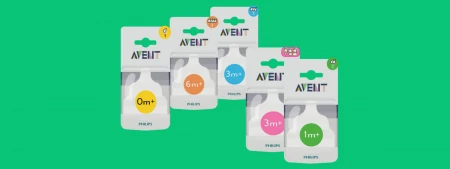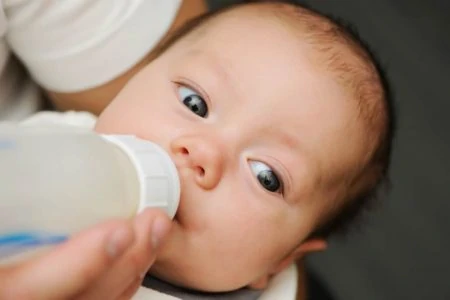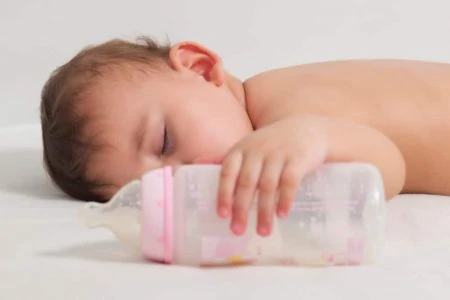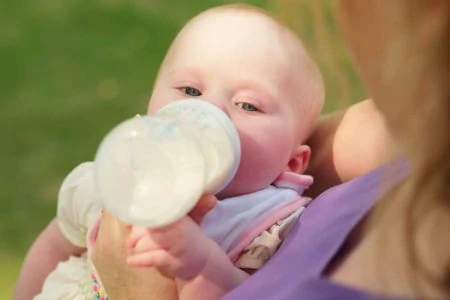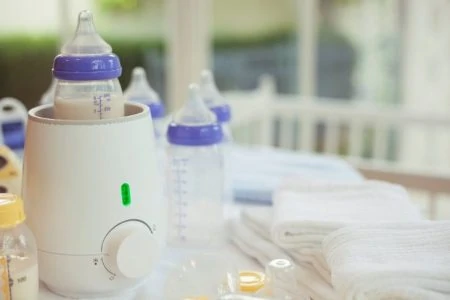Babies are creatures of habit. While a bottle and a sippy cup might look similar to you, the difference feels massive to a little one who finds comfort in their bottle.
However, experts recommend weaning off the bottle by your baby’s first birthday to prevent dental issues and promote development. We know this switch can be tricky, but proper timing and the right techniques make a world of difference.
Here are nine proven steps to make the transition from bottles to sippy cups smoother for the whole family.
Key Takeaways
- Start early: Introduce a sippy cup around six months old when you start solid foods.
- Ease the flow: Remove the spill-proof valve initially so your baby doesn’t have to suck too hard to get liquid.
- Choose wisely: Start with a soft silicone spout or a straw cup to mimic the texture of a bottle nipple.
- Use familiar liquids: Fill the cup with breast milk or formula initially so the taste is familiar.
When To Introduce a Sippy Cup
You should introduce a sippy cup when your baby starts eating solid foods, usually around six months old. At this stage, you aren’t trying to replace nursing or bottle-feeding entirely. Instead, you are helping them develop the motor skills needed to lift a cup and swallow.
Introducing the cup early without pressure helps your baby get used to it. If you wait too long, your child may develop a strong emotional attachment to the bottle, making the switch much harder. Pediatricians generally recommend dropping the bottle completely by your child’s first birthday.
Why You Should Switch
Prolonged bottle usage is more than just a habit; it is associated with several negative health outcomes. Moving to a cup helps prevent (1):
- Tooth decay: Pooling milk sugars can destroy new teeth.
- Ear infections: Drinking while lying down increases fluid buildup.
- Picky eating: Filling up on liquid calories reduces appetite for solids.
- Dental misalignment: Prolonged sucking can affect jaw shape.
- Obesity: Bottles make it easier to overconsume calories.
How to Transition from Bottle to Sippy Cup
Every baby is different. Some take to a cup immediately, while others need time. To increase your chances of a tear-free transition, try these nine strategies.
1. Start Early
Introduce the cup alongside solid foods. You can tip the spout toward their mouth to show them that liquid comes out.
Do not expect your baby to drink a full serving immediately. In the beginning, this process is about developing hand-eye coordination and muscle memory. The earlier you start, the fewer tantrums you will likely face later.
Consider giving your baby an empty sippy cup to play with. Allowing them to handle the cup may make them more likely to accept it when you use it with liquids. When your family is eating, let your baby have a sippy cup. Then see if you can get them to mimic you as you take a sip from your own cup.
Editor's Note:
Michelle Roth, BA, IBCLC2. Remove The Valve
Most modern sippy cups come with a spill-proof valve. This is great for your carpets but tough for a beginner. Babies are used to the steady flow of a bottle nipple; valves often require a hard suck that can be frustrating.
Remove the valve to let the water flow freely. Yes, it will be messy, but it helps your child understand that the cup contains liquid. Once they master the mechanics, you can put the valve back in.
3. Start With a Silicone Spout or Straw
A hard plastic spout feels very different from a soft bottle nipple. To bridge the gap, use a cup with a flexible silicone spout or a soft weighted straw.
Many bottle brands offer transition kits that replace the nipple with a spout on the existing bottle body. This familiarity can make the switch less intimidating.
4. Use Familiar Liquids
While water is the best beverage for teeth, it has no flavor. If your baby refuses the cup, try filling it with breast milk or formula.
When the vessel is new but the taste is familiar, your baby is more likely to accept it. Dip the spout in the milk so they taste it immediately when the cup touches their lips. Once they are comfortable drinking from the cup, you can swap the milk back to water for meal times.
5. Offer a Sippy Cup Instead of a Bottle
Once your child has mastered the mechanics of the cup, begin swapping it into their routine.
If you usually give a mid-day bottle, offer a sippy cup with formula or breast milk instead. If you are exclusively breastfeeding, offer the sippy cup with meals.
6. Go Easy on the Nighttime Bottle
The bedtime bottle is often the hardest habit to break because it provides emotional comfort. To phase this out, slowly reduce the amount of milk in the nighttime bottle while offering a protein-rich snack before the routine begins.
You should also separate feeding from sleeping. If you usually feed your child in the nursery, try doing the last feed in the living room with the lights on. This breaks the association between sucking on a bottle and falling asleep.
7. Quit Cold Turkey
Some parents find that weaning slowly prolongs the agony. If gradual changes aren’t working, you can simply remove all bottles from the house at once.
This method often results in a few rough days of protest, but the transition is usually over much faster. This works best for toddlers who can understand the concept that the bottles are “gone.”
8. Follow Through
Consistency is your most important tool. If you decide to ditch the bottles, you cannot cave in when your child cries for one.
Take Note
9. Quit All Bottles Around Age One
Aim to have the transition complete by the 12-month mark. After age one, toddlers develop stronger emotional attachments to objects. Breaking the habit becomes significantly more difficult the longer you wait.






